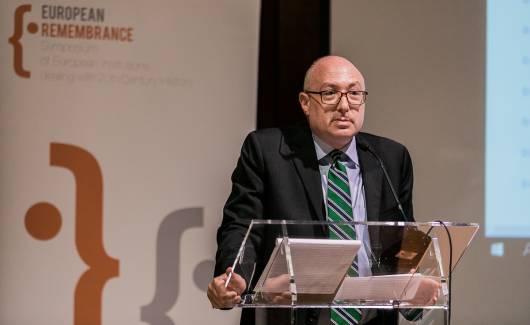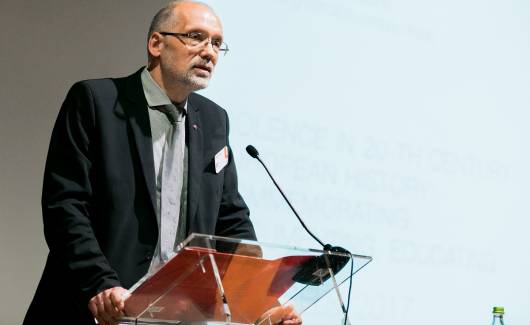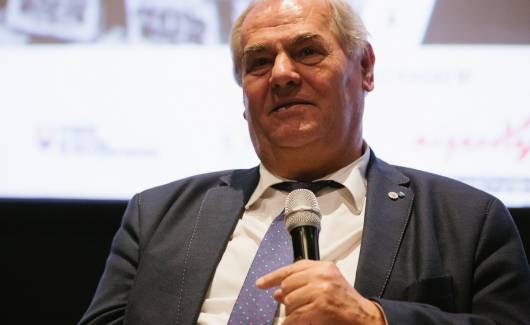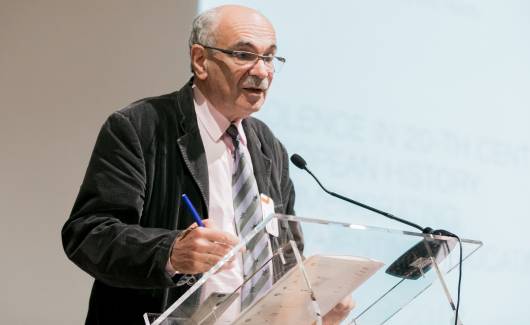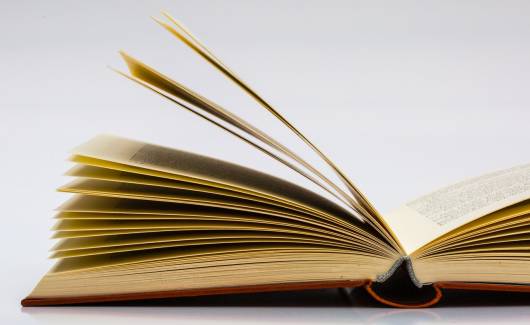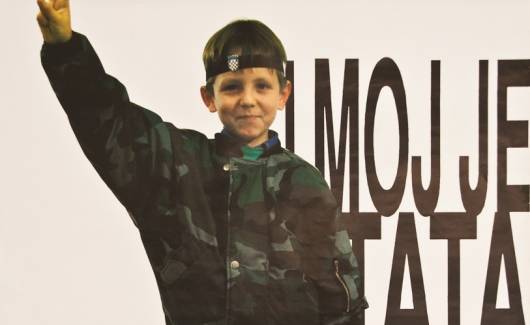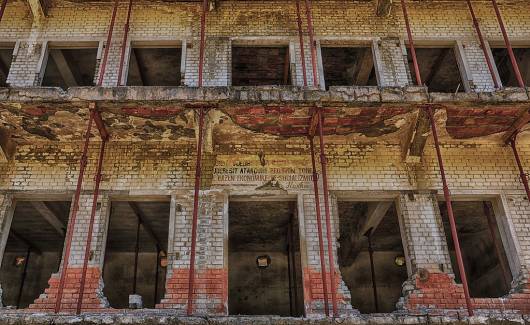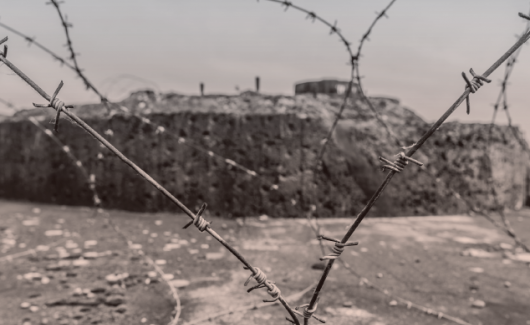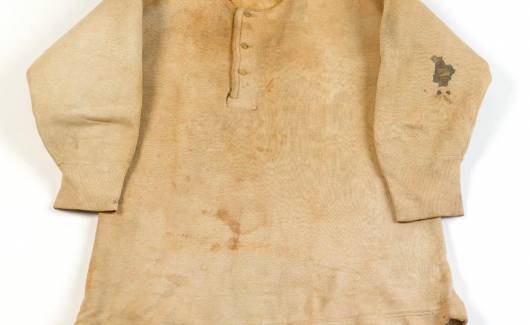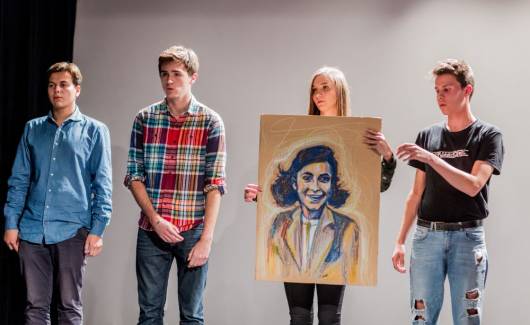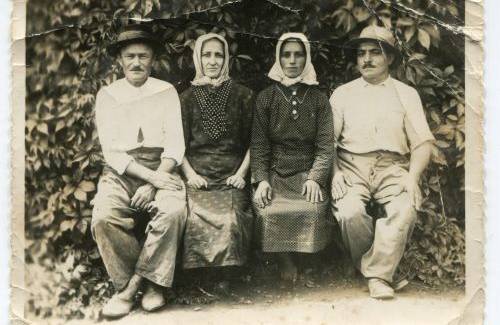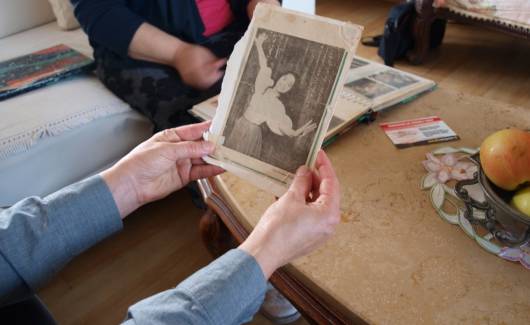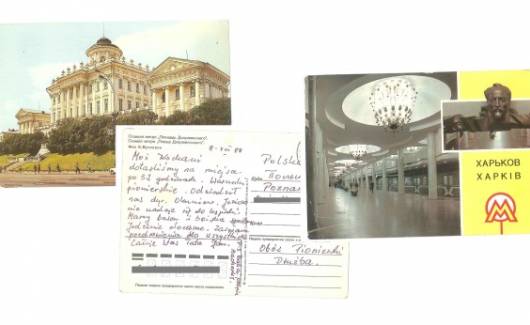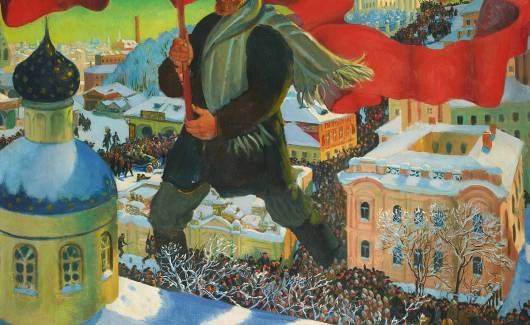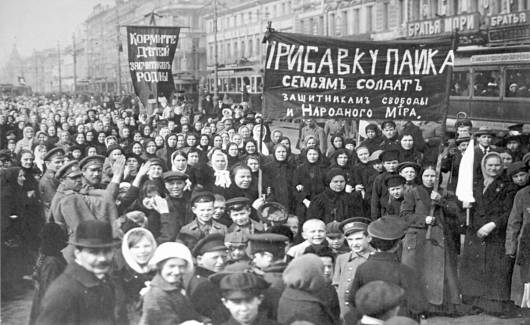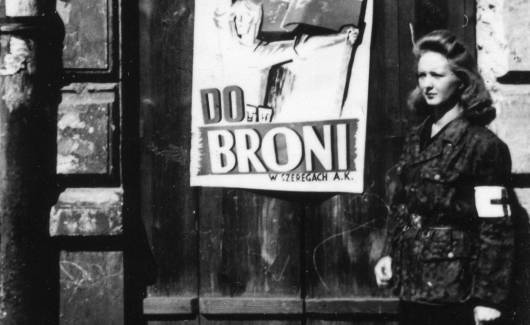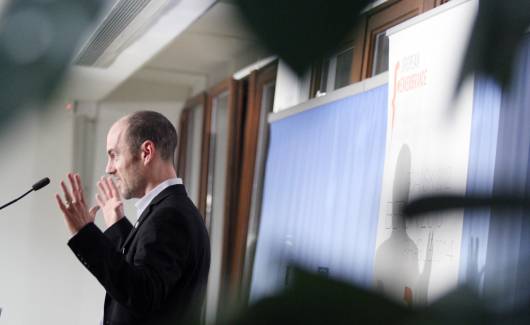This is a lightly edited transcript of a lecture given at the symposium ‘Violence in 20th-century Europe: Commemorating, Documenting, Educating’ in Brussels, Belgium on 6 June 2017.
While the topic of memory is multifarious, covering many issues of identity, belonging, pride and sorrow, the relationship between memory and violence clearly has a special significance. As a scholar of memory, of course, I am fascinated with the complexities of memory in its many forms and many referents. This is thus a welcome opportunity to think more, and perhaps more directly, about the other side of the equation. This invitation, then, has led me to think about the phenomenon – or more accurately phenomena – of violence in a more systematic and general fashion than memory scholars are sometimes inclined to do, just as it has perhaps led specialists on violence to think more about the complexities of memory than they might otherwise do.
If we are going to talk about a particular kind of remembrance – namely the remembrance of violence – we need to be clear exactly what it is we are talking about when we identify such an objective as a special one for remembrance. Like memory, however, violence is an exceptionally difficult concept to define in a robust way (so too is memory, which I will come back to later). Violence has at least two generic senses: the first refers to the very act, which is an exertion of power of force directed at an object. To be sure, we can exert violence over nature: we can blast through rock to build a tunnel, we can knock down a tree to clear a path (in the process destroying life, which gives a hint of what is essential), and it is not inappropriate to talk about the violence of nature or of our violence towards nature. But what we are primarily talking about in the context of the memory-violence nexus is the exertion of force – coercive, damaging, destructive – by one person or group of people over another person or group. We should note that violence in the human realm – in contrast to the natural – only sometimes involves a physical dimension, such as bodily injury, brutality or even death. Violence can also be a single act, a repeated act, a condition or a pervasive order in a society.
We must remember at the beginning, moreover, that not every act of violence is illegitimate. No one would dispute, for instance, that some violence is sometimes necessary: if you want to build a house, you have to clear a place, sometimes with explosive force. Even more, reasonable people would not dispute, though they might be frightened by the fact, that we need some form of policing to secure our social and physical security. Or the fact that when a terrorist attacks, the police come running and take him or her down by any means necessary. One may have concerns about the political context, but in the moment when one person or group is committing violence against another, we legitimately look to others to protect us from that violence, which they do with further – this time hopefully justified – violence. So not all violence is illegitimate or unjustified (all scepticism about ‘just war’ notwithstanding). A world without violence is not, in the words of the philosopher Gottfried Leibniz, the best of all possible worlds. In reference to Sigmund Freud’s ‘Beyond the Pleasure Principle’ – an enduringly relevant text for an understanding of violence, of memory and of the relations between them – to wish for a world free of violence is to wish for a world that is bland, inhuman, narcotized, an existence of what would in fact be an order without meaning. We recall as well – as Professor Wieviorka already mentioned in his lecture on the first day of this symposium – the sociologist Max Weber’s famous definition of states as those agencies that have a monopoly on the legitimate use of violence. So, again, not all violence is illegitimate. What qualities then, other than just the act, are we referring to when we are discussing violence?
The second sense of violence is not just the generic sense of violence as force – legitimate or illegitimate. Rather, the specific meaning that I think is at issue when we talk about violence in relation to memory – as I have been charged to do here – is violence that is the expression of an etymologically related term, namely violation. Not all violence involves violation. When you go to the doctor and have to have surgery, there is clearly violence involved – the cutting into flesh – but because its goal is to help you and presumably you consent to it, such an act is not a violation, though you may in fact feel it that way. In contrast, it seems to me, the violence that is at issue in our contemporary moral and political – and indeed memory – culture is that of power that violates or transgresses norms, particularly norms of human inviolability, our sense of order, of appropriateness and of integrity, physical and moral. Here it is important to note that while Weber may have pointed out that states may have a monopoly on the legitimate use of violence, that is not exactly the same thing as a monopoly on the use of legitimate violence. We know that much of what states have done to each other and to their peoples and to other peoples was not legitimate violence, even if, with the power of their armies and their control of the streets they had a monopoly on its use. This is because their violence has violated rules and norms, integrity bodily and moral. And these kinds of violence/violation create particular problems for memory.
Yet another issue to raise about violence in framing the question of the relationship between violence and memory is that, like everything else, violence has a historical development. Recently, for instance, the cognitive psychologist Steven Pinker, based to some extent on the ideas of the sociologist Norbert Elias, has argued that despite the horrors of illegitimate violence in the 20th century – effected particularly through our extraordinary means of inflicting it on mass scale – the absolute amount of violence in the world today has in fact been in steady decline. Whether or not one believes Pinker’s data or Elias’s argument about the so-called ‘civilizing process’, one thing is clear: our expectation of violence and our tolerance for it, at least in public discourse, has indeed decreased (though of course this decrease is not universal or evenly distributed). This too – the unexpectedness of violence/violation – contributes to its mnemonic challenges.
Just as an illustration – not in a manner that is going to prove anything to a rigorous social scientist – we might consider some ‘data’ from Google Ngram. If one is to search the frequency of the term ‘violence’ in the titles of English language books from 1800 to the present, precisely at the time when there was the most shocking violence being perpetrated on a mass scale, we find that there was a substantial dip in the number of mentions of violence, bottoming out in about 1917. The frequency then remains relatively steady up until about 1950, when uses of and references to the concept of violence only then return to the level of mentions in the early 1800s. Of course, one of the things that has changed in this time is what exactly we meant by violence at the beginning of the 1800s and what we mean by it in the second half of the 20th century. In some ways, this is an indication of the changing presence of a discourse about violence, though of course we must recall that the term and its meanings do not strictly coincide and thus that frequency is a limited indicator. Whether or not this index of uses of the term violence indicates a change in the amount of violence, then, it at very least indicates something about the change in the way we think about (and remember) it.
Indeed, it is not the absolute amount of violence in the 20th century that has caused the move from what has been called a culture of monuments to a culture of memorials, from one of heroes to one of victims, to one of national identity to one of human rights. Rather, it is our moral universe that has changed, and it is this change that is indicated in the changing frequency – and indeed nature – of references to violence. This is not, however, to discount the very real changes that have taken place in the forms and contents of the violent practices that have taken place in the contemporary world, for indeed there are new kinds of violence and new conditions for knowing about them. So, for instance, the new violence of the 20th century is not the violence of nature or even the violence of God against man – an earthquake, a catastrophe, a fire – but that of man against man. But it is a different kind of violence of man against man. It is not a raiding tribe, an act of vengeance or personal expiation, nor violence toward some end or for some purpose. Rather, it is mass violence, though it is important to remember that even mass violence – which depends on mass society – is itself a diverse and multifaceted phenomenon.
One of the most interesting features of contemporary violence is not merely its mass nature, however, nor is it merely our preoccupation with it in our changed (by violence) moral culture. What we have seen in the late 19th and early 20th century, rather, is the emergence of new forms of violence that are only enabled by changed conditions, namely the rise of mass society, but also of industrialization. We use today quite glibly the term trauma in many contexts. And if you were to ask many history students or ordinary people – not that history students are not ordinary people – what trauma means and where did it come from, they might make reference to the concept of post‑traumatic stress disorder that arose in the context of the Vietnam War. And if one were to ask historians, they would likely make reference to an earlier period, namely the First World War and the concept of shell shock or war neurosis. But in fact the historiography of trauma shows clearly that the concept emerged in an earlier period, namely the 1860s to the 1880s. What was happening in those years that gave rise to our contemporary concept of trauma? One of the things that happened was a great epidemiological expansion in the experience of trauma. I do not mean that modern people suffer more or are more miserable than people before the modern industrial era. What I mean is that the ways in which we suffer have changed with mechanization.
In a marvellous book on the railway journey, the cultural historian Wolfgang Schivelbusch describes the radical novelty of the experience of riding in a railway car. If you ride a horse or even a stagecoach, you are still in a direct connection to biological power – the power of the horse. You experience the passage through space, the bumps of the road, the curves, in a humanly comprehensible fashion. Once you experience the speed of the railway journey, you are taken into a radically new realm. One of the things that happened with the advent of railway journeys – although with railway journeys being only one example of industrial experience – is the rise and spread of accidents. To be sure, one could always fall off a horse or have a stagecoach crash. But there was a categorical difference between the experience of being injured through bio-power and being injured through an industrial mechanism, one that created existential ruptures. This is to some extent what the philosopher Martin Heidegger was addressing in his distinction between the windmill and the power plant: the former is still comprehensible to ordinary people, while the latter is beyond the comprehension of most of us. And these new experiences required new concepts for understanding. This is the birthplace of the modern sense of trauma.
While war neurosis was not new in the 19th century, its scale and severity were. And this is why the philosopher Walter Benjamin, for instance, diagnosed the experience of the First World War as a civilizational rupture. In his famous essay on the ‘Storyteller’, Benjamin wrote, ‘Never has experience been contradicted more thoroughly than strategic experience by tactical warfare, economic experience by inflation, bodily experience by mechanical warfare, moral experience by those in power.’ So what has happened with the advent of industrial warfare, marked most clearly by the First World War, although it has been tied up with industrialization more broadly, is the loss of a direct human experience, a sense of measure, a sense of control. If you recall your US Civil War movies, you will remember the plan of battle, in which two armies stand in lines facing each other, affix bayonets and then walk towards each other until they meet. In US Westerns, the cliché is ‘don’t shoot until you see the whites of their eyes’. The First World War was categorically different. There the average soldier grovelled in trenches, and the biggest threat was insidious: a gas one could not see and whose effects one could not fathom. In order to protect himself, the soldier donned a mask that turned him into an extra-terrestrial monster, the likes of which medieval theology could not begin to understand.
Despite the importance of the First World War – and industrialization more broadly – in our experience of violence and in our ability to understand it, the Shoah was the second blow in the death on a human scale. The Shoah introduced us to what philosopher and survivor Emanuel Levinas so poignantly described in his work as ‘useless suffering’. What is Levinas getting at with this concept as an interpretive frame for the Holocaust? He is saying that the ‘events’ are in fact not ultimately interpretable or comprehensible. The framework in which Levinas addresses this is in fact a much older one – tracing back all the way to Leibniz, who I have already mentioned: namely that of theodicy. Theodicy is the explanation of evil and suffering. What meaning can we give to our miseries? In the period after Leibniz published his treatise on theodicy in 1710, Europe experienced a major crisis in the earthquake that hit Lisbon in the middle of the 18th century. How could you explain, how could you defend God, or any notion of his benevolence, when fires consumed children, innocents, civilians? This was not a phenomenon of war, but a ‘natural’ event that seemed to have no purpose. This moral crisis begun in the middle of the 18th century received exceptional clarity by the middle of the 20th century, when Levinas posed it again, but in contrast to Leibniz, saw no possible answer to it. This is because the conditions for making meaning had changed along with the new forms of suffering that demanded such meaning.
The question of theodicy, of course, is one that underwrites the entire history of Western moral thinking, from the Book of Job onwards. Job, who was made to suffer for no good reason, never lost his faith. When he demanded an answer, it was one that has resonated throughout the ages: Job was not entitled to, or capable of understanding, an explanation. And so Job’s only recourse was to live in resignation. But Job’s suffering was an individual, personal suffering (or at least was portrayed this way, despite the destruction of his family that caused him to suffer), while the suffering of the 20th century was a categorical suffering on a mass scale, and thus not one to which resignation is a judicious approach. One cannot simply say human beings are mortal, we experience illness and pain, and this is a part of life. There is no existential scale that can contain the knowledge of what happened in Auschwitz.
Here too it is important always to historicize. The question of theodicy, our ability to come up with explanations that make sense of the suffering we have experienced or witnessed, has itself changed dramatically over time. This goes back, again, to Max Weber, in whose work we also see a discussion of theodicy. For Weber, it was a matter of how poor people might ‘come to terms’ with their misery. Weber’s answer was that they create salvationist religions; they believe that their suffering in this world will be redeemed in the next, the Christian idea that the meek shall inherit the earth. What Weber points out in his discussion of theodicy, however, is that the ability, the conditions for us, to come up with a satisfactory explanation, have in fact diminished in modernity. If your house fell down and your family was killed by an earthquake in the middle ages, we would have said, like Job, that we must have done something wrong – not prayed hard enough, etc. God must be angry with me. But with the rise of science, we understand how plate tectonics work and we theorize stochastic processes, statistical randomness, etc. We understand that there may not be any true meaning, which is to say purpose, that can be ascribed to something like an earthquake. It hits where it hits, when it hits.
One of the things we try to do, and we have seen this in the late 20th century, is that we try to hold each other accountable, even for natural disasters. So when an earthquake hit Aquila, Italy in 2009, the Italian government put the seismologists on trial, and indeed convicted them for not providing adequate warning to the population. Following the Southeast Asian tsunami of 2005, we blamed overdevelopment, incompetent governance and failure to respond adequately to climate change. While it is also true that Jean-Jacques Rousseau disputed the naturalness of the destruction in Lisbon in 1755 – pointing out that it was not nature that dictated building flimsy dwellings on hillsides or dense clusters of wooden structures that would burn so quickly – the general trend has been towards the increasing difficulty of coming up with satisfactory explanations of how our suffering is meaningful.
So what does this have to do with the topic in hand? It seems to me that the link connecting violence to memory is to recognize that memory is a form of theodicy. That is, memory, particularly the act of commemoration, is a way of ascribing meaning to what has happened in history, to suffering, a way to redeem suffering in some fashion or other. Here I am moved, however, by the philosopher Paul Ricoeur who, in his discussion of Levinas and of the problem of theodicy, argues that every theodicy is an exercise in bad faith. That is, every time we offer an explanation for suffering that enables us to see how it happened and fix the problems in the name of ‘never again’, we are retrospectively assigning meaning. (This can include a scientific explanation about the facts that led to an atrocious outcome, for instance, an explanation that might refer to human psychology or bureaucratic organization or administrative complexity and the perfect storm of conditions and events that led to Auschwitz.) But not everything, or not everything completely, can be explained in this manner. To try to do so is to risk ‘bad faith’, move from explaining something to explaining away, or making it seem necessary in the service of some larger or longer end.
In the lecture we heard a few days ago by Professor Wieviorka, we learned that violence has a complex social geometry to it. So too does memory. When we analyse violence, we need to be careful that we specify the geometry of perpetration and victimhood. Are the perpetrators acting as individuals or as members of groups? Who are the victims? What is the power relationship between the perpetrators and victims? Are they symmetrical or asymmetrical? Do they remain in contention or does one side triumph over the other? To what extent? One of the conditions of post-war Germany, for instance, was that the Holocaust was in fact largely successful – not merely in eliminating the lives of six million people, but in removing Jewish life from German culture and society. When we use the term violence, moreover, we need to be careful not to overgeneralize a variety of different phenomena into one category. Violence can be once, it can be a condition, it can be enduring, repeated or none of these. It can be reciprocal, can have meaning or can be devoid of meaning.
In the same way, we can analyse the complexities of memory. In the emerging field of memory studies, there is a great discussion about the relationship between individual memory and collective memory. Does collective memory exist, or is it merely a metaphor? Memory can be unitary – that is, there can be a single agreed set of memories in a group that one must share or at least know in order to be a member of the group. More often, however, memory is contested and fragmented; there may be hegemonic memory, official memory, top-down memory or bottom-up memory. Memory also takes on different emotional and epistemological registers. Memory can be historical, documentarian, expressive, an effort to seek redemption, etc. One of the features of memory that we do not see clearly enough when we are analysing violence is the profound temporality of memory, the fact that memory is not just an act in the present, nor a direct reference to the past, but a reference to the past in the present that is nonetheless conditioned by its place in the history of such commemoration. In other words, one cannot predict memory from the past or from the present. Memory is the result of an ongoing discourse of remembrance, where each version of the past follows, and in part responds to, those that preceded it; just as often, each subsequent version of the past is a commentary on, as well as departure from (and effort to transform), those earlier versions.
Since this is a conference on European remembrance, it is with great hesitation that I make reference to an American example to demonstrate this temporality of memory, though the United States has already been a significant part of the discussion at this meeting so far. In particular, there was reference to the origins of the idea of the concentration camp in Cuba (this statement itself being an effort to transform a version of the past – namely one in which the Nazis invented the concentration camp – just as the statement I am making now is an effort to transform this revised memory). In fact, concentration camps were not invented by the Spanish in Cuba; nor were they – as was a central claim by the right during the German historians’ dispute of the mid-1980s – an imitation of Stalin’s Gulags. No, the invention of the concentration camp lies squarely in the history of the United States. The first such installations in modern form were early ‘reservations’ for Native Americans. Another important reference in the history – though less so in the memory – of concentration camps was the prisoner of war camps maintained with particular brutality during the US Civil War. One of the most notorious such examples was Andersonville Prison, in which an estimated 15,000 Union soldiers died. Indeed, the prosecution of the camp’s commandant, Captain Henry Wirz, was one of the first modern examples of a war-crimes trial. Making things even more complex, however, subsequent revelations (after Wirz’s execution) revealed some merit to Wirz’s defense claims that he had tried to alleviate suffering. Wirz thus became something of a symbol for the legatees of the Confederacy, who erected a memorial to him in 1909. Memory clearly has its ups and downs, its proponents, entrepreneurs, revisionists and rejectionists.
This story is particularly interesting to me here because it has long seemed to me that there has been a sort of American exceptionalism when it comes to the study of memory as well as to the power of memory politics. A good example of this is that conferences like the present one, sponsored by a prominent and successful NGO, does not really have – or has not really had – its equivalent in the United States. However, it does seem as if this American exceptionalism is coming to an end – and not least in part because of the influence of European memory politics as a model, and of the spread of the politics of regret as a principle of legitimation here in Europe. Indeed, this has been taking place in just the last year, when the United States has experienced a wave of commemorative debates and politics. While there have been numerous tributaries from every direction, these were brought together into a mighty river of discourse with the murderous attack of a white supremacist on an African-American church in South Carolina in June 2015. Only following this event – which took place after decades of criticism of officially sanctioned Confederate symbolism – did the governor of South Carolina unilaterally – though with substantial support from across the spectrum – act to stop flying the Confederate flag from the dome of the Statehouse.
Since then, there has been a great deal of new introspection – or at least more widespread introspection – about the shameful and problematic presence of the American past. To be sure, much of this introspection has taken place at the top of the intellectual food chain, and resistance to such thinking was not an insignificant part of the cultural background that has brought us a radical populist presidency (if that is indeed what it is). For instance, Georgetown University ‘discovered’ that its present financial security was built on the sale of more than one hundred slaves that the university – itself associated with the Catholic Church – owned. In the present context (begun before the South Carolina massacre), the university has undertaken – quite honorably, in my view – efforts to expiate this crime, including setting up a memory institute. A similar discussion took place recently at Yale University, where several buildings and institutions at the university made historical references in honour of individuals that many have come to understand – at least by contemporary standards – were perhaps not so honourable (in the literal sense) after all. For instance, one of the undergraduate colleges at Yale was named for John C. Calhoun, the seventh vice president of the United States who made his fortune in the slave trade. For decades, Calhoun Hall was the proud undergraduate residence and association for many of the United States’s present elite. The discussion began around the question of whether the title of the head of Calhoun College – and indeed of all of the undergraduate colleges at Yale – should continue to be ‘Master’, with its evocation of the era of slavery. It was fairly readily agreed that the ‘Master’ would henceforth be called ‘Head’. Yet the question of the name of Calhoun College itself proved, at least at first, to be more difficult, with a presumption against ‘changing the past’. It took a further year to overcome alumni resistance to changing the name itself.
In just the past several weeks [note, this lecture was delivered in June 2017, before the riots in Charlottesville, Virginia], indeed, we have seen a wave of municipal authorities around the Southern United States tearing down monuments to the Confederacy. What is fascinating about these moves, first of all, is that they are happening at all, but second of all who is agreeing and disagreeing with them, and with what arguments. Indeed, in many conversations I have had at my own and other universities, including with colleagues in history departments, a lot of people have asserted that tearing down such monuments and markers would be tantamount to changing history in the name of a sanitized, politically correct memory. Markers of the Confederacy, in such an argument, are tantamount to changing the history of the Confederacy itself. What they are missing (and, again, what has been highlighted since the Charlottesville riots) is, again, the complex temporality of such history and memory. What the defenders of ‘not changing history’ neglect to ask is who built these markers and for what reasons. The monument to Robert E. Lee, which was the occasion for the riots in Charlottesville [again, these events took place after this lecture was first delivered, though the debate was already underway in early summer], was not a remnant of the war itself but was a mnemonic act undertaken by particular people in a particular place at a particular time – and for a particular purpose. Monuments like the Charlottesville Lee statue were built decades after the end of the Civil War for the purpose of expressing a white supremacist ideology.
So even though the violence being commemorated happened in the past, before the monuments were built, that violence lives on in and through the monuments marking it, which were indeed intended to perpetuate the real violence of the war with the symbolic violence of memory. We need to recognize, in other words, that memory itself can be a form of violence. When you erect or maintain a statue in a city or town centre that symbolizes the historical oppression of a group of people, and the descendants of that group of people have to walk by it every day and the dominant powers say they do not want to change the past, we are failing to recognize the ways in which versions of the past represented in monuments – versions of memory – give meaning to the original act of suffering and serve to perpetuate it. Ending the violence thus requires responding to these later acts of commemoration.
Where does this all leave us? As time is short, here, then, are some general prescriptions for the analysis of violence, memory and the relationships between them: we must take care, based on our analysis of the complexities of violence and memory, not to wash out the differences between different kinds of violence in one overarching culture of remembrance, one that often faces the choice between ‘never forget’ and its apparent opposite: ‘forgive and forget’. There are different kinds of violence, different kinds of remembrance for them and different conditions for reconciliation and meaning about different kinds of harms through a monolithic principle of remembrance. It matters whether the suffering was individual or collective, whether the perpetration was individual or collective, as well as whether the memory is individual or collective, and who is doing it for what purposes. As the discussion of theodicy showed, it matters whether the event being commemorated was a ‘natural’ event or man-made, the result of legitimate or illegitimate power, necessary and purposeful or ‘useless’. Each of these requires its own form of commemoration, and we must not overgeneralize the imperative to never forget all situations and all actors, regardless of their positions within these matrices of violence and memory and their relations to them.
The legitimacy of memory is to be found not by settling on any particular contents of memory, but on following a set of procedures, as well as resisting others, that require us to take into account the variety of different subjective and objective points of view. We must enter into constructive – and sometimes critical – dialogue with those perspectives, including those of both perpetrator and victim, as well as their descendants. In other words, we need to understand and differentiate the legitimate and illegitimate concerns of the defenders of the monuments as well as the legitimate and illegitimate concerns of those who feel oppressed by them. But understanding all points of view is not the same thing as accepting them. People’s views of the past may be authentic and even well motivated, though they may also be disingenuous and mean. But all of these possibilities are part of the analysis. At the end of the day, however, the monuments of violence that deny or celebrate, rather than merely recall, its motivations must go. Remembrance, like any act, is subject to principles not merely of authenticity or desire, but of power and politics. The culture of remembrance does not mean accepting every authentic sentiment about the past.
A further corollary of these principles, however, is that we must avoid self-righteousness and to put our own victimhood and suffering in a wider perspective. While I am not a Christian, in this I am moved by the parable of the log and the speck from Matthew: ‘Why do you look at the speck of sand in your brother’s eye yet pay no attention to the log in your own eye?’ (Matthew 7:3). Perhaps we can adapt this even when we are the victims of tremendous suffering, not to retreat into a commemorative narcissism. Instead, our remembrance should be directed toward healing the wounds of our violent past: in the Jewish vocabulary ‘tikkun olam’, to heal the world. We do so by recognizing and recalling the pain of others, not merely of ourselves. We must give up, in other words, the strong prioritization of our own personal suffering and the suffering of our own people. This is how we prevent the flame of suffering from setting the world on fire yet again. The memory of violence must not be matched by the violence of memory.
JEFFREY K. OLICK
Jeffrey K. Olick is Wiliam R. Kenan, Jr. Professor of Sociology and History at the University of Virginia and chair of the Sociology Department Chair. He received a BA with High Honours from Swarthmore College (1986) and an MA, MPhil and PhD in Sociology from Yale (1993). Current projects include a six-volume Cultural History of Memory and developing the outlines of ‘tragic sociology’, an approach with origins in Nietzsche’s writings on suffering and Weber’s sociological approach to theodicy. He works with students on collective memory, sociological theory, symbolic politics, and history and theory of ideas and meanings, among other topics. His work has been translated into Spanish, German, Polish, Farsi, Turkish, Estonian, Hungarian, Russian, Chinese, Japanese and Korean.
LIST OF REFERENCES
Benjamin, Walter (1969) Illuminations: Essays and Reflections, trans. Hannah Arendt. New York, NY: Harcourt, Brace.
Elias Norbert (2000) The Civilizing Process, trans. Edmund Jephcott (1st edn 1939). Oxford: Blackwell.
Freud, Sigmund (1961) Beyond the Pleasure Principle (1st edn 1920). New York, NY: Norton.
Heidegger, Martin (1977) ‘The Question Concerning Technology’, in Basic Writings, ed. David Farrell Krel (1st edn 1954). New York, NY: Harper & Row.
Leibniz, Gottfried Wilhelm (1985) Theodicy: Essays on the Goodness of God, the Freedom of Man, and the Origin of Evil (1st edn 1710). LaSalle, IL: Open Court Press.
Levinas, Emmanuel (2001) ‘Useless Suffering’, in The Problem of Evil: A Reader, ed. Mark Larrimore, 371–80 (1st edn 1982). Malden, MA: Blackwell.
Pinker, Steven (2012) The Better Angels of Our Nature: Why Violence has Declined. New York, NY: Penguin.
Ricoeur, Paul (1974) The Conflict of Interpretations, ed. Don Ihde. Evanston, IL: Northwestern University Press.
Schivelbusch, Wolfgang (1987) The Railway Journey: The Industrialization of Time and Space in the 19th Century. Berkeley, CA: University of California Press.
Weber, Max (2013) Economy and Society (1st edn 1922), trans. Guenther Roth and Claus Wittich. Berkeley, CA: University of California Press.
This article has been published in the sixth issue of Remembrance and Solidarity Studies dedicated to the memory of Violence in 20th-century European History.
